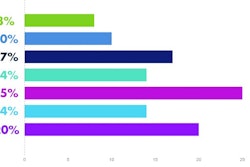
At the Nordic Pet Food Seminar 2017, which was dedicated to pet health and wellbeing, Francesca Susca, PhD, DVM, Pet Development Manager at Lallemand Animal Nutrition, gave a lecture titled: Reaching Pet Well-being Through the Modulation of the Gut Microflora: Gut, the Second Brain?
Based on an extensive scientific review of the issues related to well-being in companion animals and humans, the lecture was an opportunity to highlight the link between gut microbiota and growing concerns in dogs and cats that go beyond gut health, such as obesity, atopic dermatitis or anxiety, with special attention to the brain-gut axis, an area of expertise for Lallemand Animal Nutrition, producer of yeast and bacteria products.
The overall conclusion of Susca’s presentation was that “shaping the intestinal microbiota through supplementation with specifically selected and developed functional ingredients could be a way to optimize pets’ overall health and, consequently, improve pet wellbeing,” according to a press release from Lallemand.
Defining well-being in cats and dogs
Today, pets are often considered family members, and companion animals face the same lifestyle challenges as their owners. Their lifespan is getting longer and healthy aging is becoming a challenge, as in humans. Owners and veterinarians are seeking ways to define pet well-being. In farm animals, there are four principles evaluating welfare: good feeding, good housing, good health and appropriate behavior. These criteria can also be applied to define well-being for companion animals, according to Lallemand. Susca defines pet well-being as “the state of physical and mental health and happiness as a result of the preponderance of pleasant versus unpleasant feelings.” Some key parameters, such as “absence of disease” and “positive emotional state” can be linked to gut health and its microbiota, which could be influenced by nutrition.
The role of gut microbiota in pet health
The digestive tract of dogs and cats harbors a complex community of microorganisms, called the gut microbiota, that plays a crucial role on the host’s overall health. Recent developments in the field of sequencing techniques, with the OMICS revolution, have enlarged scientists' understanding of the microbiota and its potential functions.
The gut microbiota is a dynamic system with great intra- and inter-individual variations. Its three main functions are keys to ensuring the maintenance of the overall health of the host’s gastrointestinal tract (GIT): 1) metabolic function 2) protective function, and 3) structural function.
The complex interactions between the microbiota, the host immune system and the host’s genetics influence the balance between health and disease. Genetics, age, environment, antibiotics and diet, are some of the factors recognized as affecting the microbiota. According to Lallemand, it was shown in dogs that a relatively small amount of dietary fiber was able to detectably change the structure of the gut microbiota. In the same way, functional ingredients such as prebiotics and probiotics — well documented to influence the microbiota of many species — have shown effects on pets microbiota too as illustrated by a positive study in dogs with live yeast S. cerevisiae var. boulardii on the prevention of antibiotic-associated diarrhea. Lallemand reports that probiotics studies in pets are still scarce, but the amount of literature on the mode of action of many probiotic strains and effects in humans and other mammals are fairly good indicators of their potential for dogs and cats.
Pet disorders and pet food supplements
Some GIT disorders, both acute and chronic, are well known to be associated with alterations of the microbial communities, but it is now increasingly documented that disorders beyond the GIT such as obesity, atopic dermatitis or central nervous disorders, can also be linked to changes in the microbiota. In this context, functional ingredients that are known to influence the microbiota composition such as prebiotics, probiotics and other nutritional interventions could represent alternative approaches to tackle these issues.
Lallemand reports that a recent study in dogs indicated 90 percent of dogs supplemented with the probiotic B. longum showed improvement in day-to-day anxious behavior including reduction of barking, jumping, spinning and pacing as compared to a placebo. In addition around 80 percent showed a decrease in heart rate and an increase in the heart rate variability, indicating a more positive response to anxiety. Such a preliminary study is very positive in showing a positive effect on both behavioral and physiological signs of anxiety in dogs.
More information about Lallemand’s portfolio of microbial-based solutions for pet nutrition is available on the company's website.
















